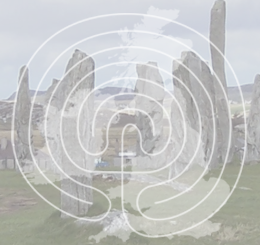The Grey Palmer
Eight miles from the city of York, amidst picturesque scenery, on the banks of the River Wharfe, was anciently the site of a Convent of Nuns of the Cistercian order. There was a contemporary monastery of monks at Acaster Malbis; and tradition relates, that a subterranean passage afforded the inmates of these establishments access to each other. In the year 1281, the Lady Abbess of Nun Appleton called upon the Archbishop from Cawood, and the nuns of St. Mary’s Abbey, to chant high mass on the Eve of St. Mark, to lay at rest the wandering spirit of Sister Hylda, which had haunted the convent, the monastery, and adjacent country, during seven long years.
 The peasants, adds the narrative, fled from that district, for the spirit appeared to them in their houses, or floated over their heads in passing the Wharfe. A tempest, with loud, dismal, and portentous bowlings, shook the high, craggy cliffs above Otley: fierce and more fierce it whirled along the river, and sent levin bolts and red meteors over the cloisters of Nun Appleton; showers descended like rolling sheets of water; and the Wharfe, swelling over its banks, washed rocks from their base, and lofty trees from their far-spreading roots. The holy Archbishop stood, in sacred stole, before the altar — the veiled sisters of St. Mary’s stood by the choir, and the monks of Acaster Malbis waited the solemn call of the bell to raise their voices in hymns of supplication — the walls resounded with knocking at the convent gate — the porteress held her beads, and crossed her breast as she said to herself, while advancing to the portal, “Here come other pilgrims of Palestine, foretold by the dreary ghost of Sister Hylda.”
The peasants, adds the narrative, fled from that district, for the spirit appeared to them in their houses, or floated over their heads in passing the Wharfe. A tempest, with loud, dismal, and portentous bowlings, shook the high, craggy cliffs above Otley: fierce and more fierce it whirled along the river, and sent levin bolts and red meteors over the cloisters of Nun Appleton; showers descended like rolling sheets of water; and the Wharfe, swelling over its banks, washed rocks from their base, and lofty trees from their far-spreading roots. The holy Archbishop stood, in sacred stole, before the altar — the veiled sisters of St. Mary’s stood by the choir, and the monks of Acaster Malbis waited the solemn call of the bell to raise their voices in hymns of supplication — the walls resounded with knocking at the convent gate — the porteress held her beads, and crossed her breast as she said to herself, while advancing to the portal, “Here come other pilgrims of Palestine, foretold by the dreary ghost of Sister Hylda.”
She turned the lock with difficulty: it seemed to deny admission to the stranger, but gave way to the arm of the porteress, and a Palmer, clad in grey weeds of penitence, strode within the threshold, the thunder burst over his head, the lightnings flashed around his gigantic figure, and in a hoarse sepulchral voice, he thanked the porteress for her gentle courtesy. “By land, by sea,” said the Palmer, ” I have proved all that is terrible in danger, or awful in the strife of war. My arm wielded the truncheon with gallant Richard, the chiefest knight of the Holy Rood; and the Paynims of Acre, with their mighty Soldan, have quaked in the tumult of our crusaders. The storm of the Red Sea and the rage of open ocean have rattled in mine ear. I have crossed burning sands, and met the wild lords of the desert in shocks of steel; but never was my soul so appalled as by the rage of elements this horrible night. To the sinner naught is so fearful as the workings of Almighty wrath in our lower world. I have visited every shrine of penitence and prayer to purge the stains of crime from this bosom: I have trodden each weary step to the Holy Sepulchre in Palestine; I have knelt to the Saints of Spain, of Italy, and of France; I have mourned before the shrine of St. Patrick, and every saint of Ireland; in Scotland I have drunk of every miraculous font, and holy well; and but for the swollen waters of Wharfe, I had sought the grey towers of Cawood, or the fair Abbey of Selby, to crave prayers from the pure in heart for the worst of transgressors. At holy St. Thomas’s tomb, my pilgrimage ends. But for the wicked there can be no rest. The pelting hailstorm, the dark red flashes of lightning and the flooded Wharfe, opposed my course. I wandered through the dark wood — the thunder roared among the groaning oaks — the ravenous wolf rushed from his den across my path, with open jaws, ready to devour me. A spectre, more fell than the savage beast, drove him away; the croaking raven and hooting owl sung a death-warning; and the spectre shrieked in mine ear, “Grey Palmer, thy bed of dark, chill, deep earth, and thy pillow of worms, are prepared. Thy childless bride waits to embrace thee!” Deeply sounded the bell. “Haste thee, haste thee, holy Palmer,” said the porteress; “the spectre of Sister Hylda bade the Lady Abbess expect thee. Haste thee to join the choral swell. Why quakes thy stately form? Haste thee, the bell hath ceased its solemn invocation.”Scarcely had the Palmer entered the chapel, when the seven hallowed tapers, which burned perpetually before the altar, expired in blue hissing flashes — the swelling choir sunk to awful silence — a gloomy light circled round the vaulted roof — and Sister Hylda, with her veil thrown back, revealed her well-known features; but pale, grim, and ghastly as she stood by the Palmer, who was recognised as Friar John.
The Archbishop raised his expressive eyes in prayer; the cold dew of horror dropped from his cheeks; but in aspirations of prayer, his courage returned, and in adjurations by the name of the Most High, he demanded of the spectre why she broke the peace of the faithful. With fearful agitation she replied: “In me behold Sister Hylda, dishonoured, ruined, murdered by Friar John, in the deep penance vault. He stands by my side, and bends his head lower and lower in confession of his guilt. I died unconfessed, and for seven years has my troubled, my suffering spirit walked the earth, when all were hushed in peaceful sleep but such as the lost Hylda. Your masses have earned grace for me. Seek the middle pavement-stone of the vault for the mortal relics of a soul purified and pardoned by the blood of the Redeemer. Laud and blessing to his gracious name for ever!”
Soft strains of melody swelled in the air and a bright flame rekindled the holy tapers, but Sister Hylda and the palmer vanished, and were never seen more!
[Abbeys, Castles, And Ancient Halls of England and Wales by John Timbs]
Nun Appleton Priory was a priory was founded around 1150, by Eustace de Merch and his wife Adeliz de St. Quintin . It was dissolved by 1539. Nun Appleton Hall, stands on the site of the Priory now. The above story is set in 1281, and according to ‘A History of the County of York: Volume 3’ (1974), a series of injunctions were issued to Nun Appleton by Archbishop Wickwane that year. ‘The prioress was to be more diligent in her duty than heretofore. No nun was to appropriate for herself any present of clothing or shoes, given her by anyone, without the consent of the prioress. All that the prioress received in money or kind for the use of the monastery, she was not to receive alone, but in the presence of two or three of the older and wiser of the nuns and at the end of the year she was to reckon up before the seniors, chosen for that purpose, the receipts and expenditure of the house. No one was to be received as nun or sister of the house, or even to live there, without the archbishop’s special licence, but honest hospitality for a day or night was not meant to be forbidden, so that no occasion of sin or scandal arose. Locks on forcers and chests the archbishop forbade, unless the prioress, very often inspecting the contents, should make other honest order in this respect. The refectory and cloister were to be better guarded from strangers than was wont, lest the good fame of the nuns should vanish hereafter more than it had already done.’




Recent Comments